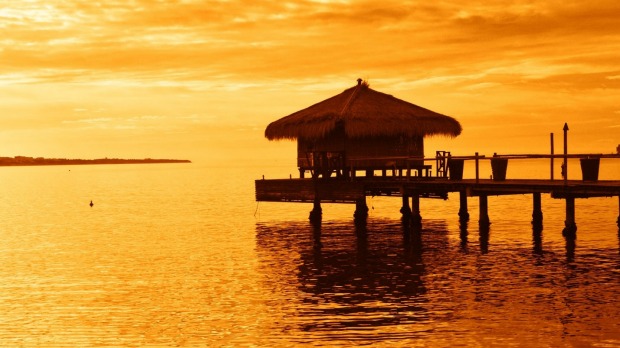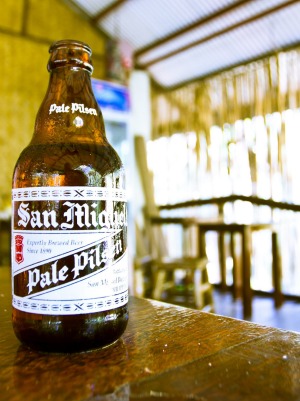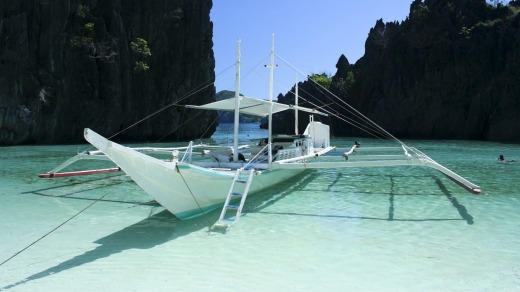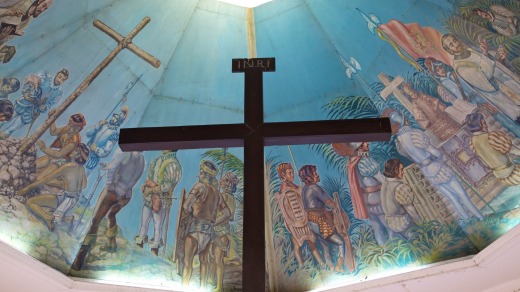
Things rarely end well on the top of skyscrapers. Ask anyone – King Kong, Doctor Octopus, Hans Gruber – they all fall slowly, clawing at the air with terror on their faces.
The rooftop of the Grand Tower in Cebu City is 45 storeys up. Standing on the parapet, I'm nudged by warm breezes and the fear is such that my eyes water and the city lights are smeared like raindrops on a pane.
I step from the edge and into the void. The zip-line sags and panic rises into my throat. I fly 75m through the night to the top of another tower until a savage braking system has me flung around like a ball on elastic. Any relief at having made it across is offset by the knowledge I must now be winched slowly back…

A tower-to-tower zip-line is not what I expect from the Philippines. But nothing's quite what I expect from the Philippines, the nation that likes to say of itself "We eat like the Chinese, pray like the Spanish and talk like the Americans".
If the zip-line gives me an overview of a city, the flight into Cebu puts an unusual Asian nation clearly in the picture. I fly over great hunks of uplifted land in pale-blue equatorial seas, just some of the 7200 islands that make up the Philippine archipelago. It strikes me that 7200 islands would have an awful lot of coast and I'm astonished to learn that the Philippines has 30 per cent more sand and sea than even our vast island continent. It's the fourth longest coastline in the world.
Cebu's coral coast is famous among the Philippines' middle classes who holiday here, as well as a significant contingent of Koreans. But judging by the dearth of Westerners, I conclude that in Australia at least its fame hasn't gone much beyond a mention in Orinoco Flow by Enya.

The actual resort area of Cebu is on a huge island province called Mactan (which I suppose wouldn't have rhymed so well with "Peru"), and the hotels are fledglings compared to the glittering many-winged multiplexes of Koh Samui, Kuta and Halong Bay. The perfectly charming Be Resort is typical – a medium-size hotel that has 4-star aspirations, 3.5-star finish, a modest infinity pool and its own little beach of crushed coral.
The beach is where I'm dining on my first night, only I'm late. Local guide Tony waves away my apologies: "Don't worry, don't worry," he says, "in the Philippines we believe in siesta, fiesta and manyana." Then he invites me to a fight.
A boodle fight is a Philippine tradition where two rows of cross-legged diners sit facing each across platters of heaped food. It's a hands-only contest, and the quickest gets the mostest. I dive into piles of fish, eggplant, chicken, pork and rice – a delicious, lively banquet that leaves no doubt of the influence of Chinese traders who first began plying the islands in the 9th century.

Next day, $30 provides a day-long island-hopping experience. It's a staple of Philippine tourism, facilitated by a large banca, an outrigger that strikes an iconic pose with its white bamboo wings flying over turquoise waters. During an hour-long transit, one of the bana crew harvests a net full of poison-tipped sea urchins, which he deftly de-spikes and hatches for each of us to taste.
"Swee t… salty," says the sailor, using his knife to prod a slimy sac around its de-spiked shell. He's right. It's surprisingly good.
The island of Hilutongan is home to fisherman who until recently used dynamite to harvest their catch; these days, they make better money offering accommodation in thatched huts on stilts and charging $2.50 to divers and snorkelers visiting their sea sanctuary. The coral has seen better days but the fish have certainly fought back, offering an array of all things striped, beaked and spotted.
On the neighbouring islet of Nalusuan, seafood is served up in a tsunami of lunch. Sitting at crude wooden tables beneath palms, we eat off paper plates, messily devouring char-smoked prawns, squid, crab, local salmon and an alien-looking cray called a sea-mantis. Thatched shacks sell cold drinks from ice-chests.
I recognize it all from backpacking days in Thailand, 25 years ago – relaxed, affordable, low impact.
☆ ☆ ☆ ☆ ☆
After my bone-white fingers are unlaced from the zip-line I immediately seek out one of the Grand Tower's bars. The young ladies who serve me have an American accent bequeathed by the overseers and educators who ruled from 1898 until 1942 (when it was the turn of the Japanese to have a bash).
They leave me a "check" and I'm reminded again that the Philippines is cheap – super-cheap, old-school cheap, Bali-30-years-ago cheap. A beer in an upmarket development like the Grand Tower costs US$2. Zip-lining off an upmarket development like the Grand Tower costs A$12. Add another $2.50 and they'll chuck in a buffet meal.
But the beer is not Budweiser, it's San Miguel – "Saint Michael" – brewed here in Cebu, and just one legacy of Spain's 400-year rule. European colonial powers have come and gone in Asia but few could claim to have had such a lasting influence as the Spanish in the Philippines.
In 1521, the handsome Conquistadors landed with their signature steel helms. But the real hard-heads were the tonsured priests who had the herculean task of converting 7200 islands to Christianity. They had to start somewhere. And that somewhere was Cebu.
The old part of Cebu City is home to hacienda-style buildings, long edifices of arches and balconies made weary by too many people and not enough maintenance. At the epicentre is a square and a small chapel that barely warrants a second glance.
The Shrine of Magellan houses a wooden cross two metres high. "This cross is made of native hardwood," says guide Tony. "Inside this is another cross – the original wooden cross that was planted by Ferdinand Magellan in 1521."
The chapel ceiling has murals depicting invaders standing over kneeling Malayo-Polynesian people who are erecting said crucifix. I'm tempted to ask Tony whether the Spanish imposition was resented, but the two peoples in the mural are really the ancestors of the modern country named for then-king Philippe II. The Magellan relic – although completely hidden – is sacred enough to attract a steady stream of pilgrims offering prayers and lighting candles.
Next door is the Santo Niño Church, a substantial basilica rebuilt of stone in 1739 to resist earthquake and fire. People pour through a gate into a walled quadrangle where a huge outdoor mass is underway; a priest intones sombre incantations while vendors patrol at the edges clutching great clouds of shiny Spongebob and Bart Simpson balloons. Within the brightly lit basilica, people queue to rap thrice on a glass case containing an icon of the infant Jesus, asking for alleviations to hardships in health, love and money.
The Philippines is one of the world's fastest growing economies but its number one export is still its people – its maids, its nannies and its merchant navy crews who work overseas for months, sending money home to their families.
Extraordinary disparities between rich and poor are still evident, a fact driven home to me not at the basilica but in, of all places, a furniture factory.
On the outskirts of Cebu are vast sheds that smell of sickly sweet adhesives, and a yard where workers play a fierce variation of volleyball. A carefully designed showroom however is quiet and pristine, a space of cold air that smells of cinnamon. It's hosted by a tailored young man who speaks for furniture maven, Kenneth Cobonpue.
Feted by the world's press and Hollywood stars, Cobonpue's designs are plaited, woven and steam-shaped into extravagant forms. "This chair costs around $3500 dollars," says the host beside a luscious leaf of velvet. "Kim Kardashian bought one. She said it reminded her of a vagina and she had to have it."
After 30 minutes, the host initiates a video to further explore Mr Cobonpue's sensibilities – at which I quietly escape to do some exploring.
Next door is a huge cemetery hidden behind a two-metre wall. I pass through a gate and enter a bizarre maze of tight corridors formed by stone tombs stacked high. It's like a warehouse of the dead. I'm startled to find chickens and goats in the narrow alleys; behind the bars of a family mausoleum I see two guys sleeping on stone slabs, their meager belongings in bags. Small children squat beside marble squares inscribed with names of the dead. A little further into the gloom, I find a group of older women smoking cigars and playing cards for money.
They eye me cautiously, and I smile awkwardly, realising these are some of Cebu's poor and this is where they live. Of course our two worlds collide and the awful truth of disparity escapes no one – not me, the person with obscene amounts of money eyeing off chairs that cost $3500, and not them, the people with obscene amounts of nothing.
And for a moment I feel exactly as I did on the zip-line. On a precipice. Uncomfortable. And invigorated to be somewhere that's bewilderingly, brilliantly, blindingly foreign.
One of the less trammelled parts of Asia, the Philippines offers plenty of "who-knew?" moments…
The sound of the Jeepney: put some extra funk into your Manila tour by climbing aboard one of Jeepney Tour's 20-seat vehicles which come complete with karaoke machines... jeepneytours.com/
Camiguin Island: Camiguin offers more volcanoes per square kilometre than any other island on earth. Twenty cinder cones and stunning surrounding waters make it a true adventure destination.
Zubuchon: the food outlet where pork obsession meets fast food meets fine art. This five-cafe chain in Cebu started life when Anthony Bourdain tried the founder's signature "Lechon" coconut-basted pork and called it "Best pig ... EVER!" Bourdain was right.
Supermarket shopping in the Philippines: check out western brands like Vans and Levis at half price. Why so cheap? They're all manufactured here.
Snorkel with whale sharks half the year round: the world's largest concentration of whale sharks are in Donsol (Luzon ) where the monster fish are reliably seen December to May and sometimes November to June.
See http://itsmorefuninthephilippines.com/cebu/
Cebu Pacific Air now flies from Sydney to Manila four times a week. Flights are around $400 one way but specials start at $200. cebupacificair.com
Rooms in Be Resorts Mactan Island start at $105 per night. Boodle on the Beach costs $45 drinks included, beresorts.com/ Overwater shacks on Nalusuan cost $90 per night, nalusuanislandresort.com/ The Grand Tower is part of the Crown Regency Hotel and Towers complex: the Tower Zip costs $12; rooms at the hotel from $100 per night See crownregencyhotelandtowers.com/
Kenneth Cobonpue see kennethcobonpue.com/
Max Anderson was a guest of Cebu Pacific Air and Philippines Tourism.